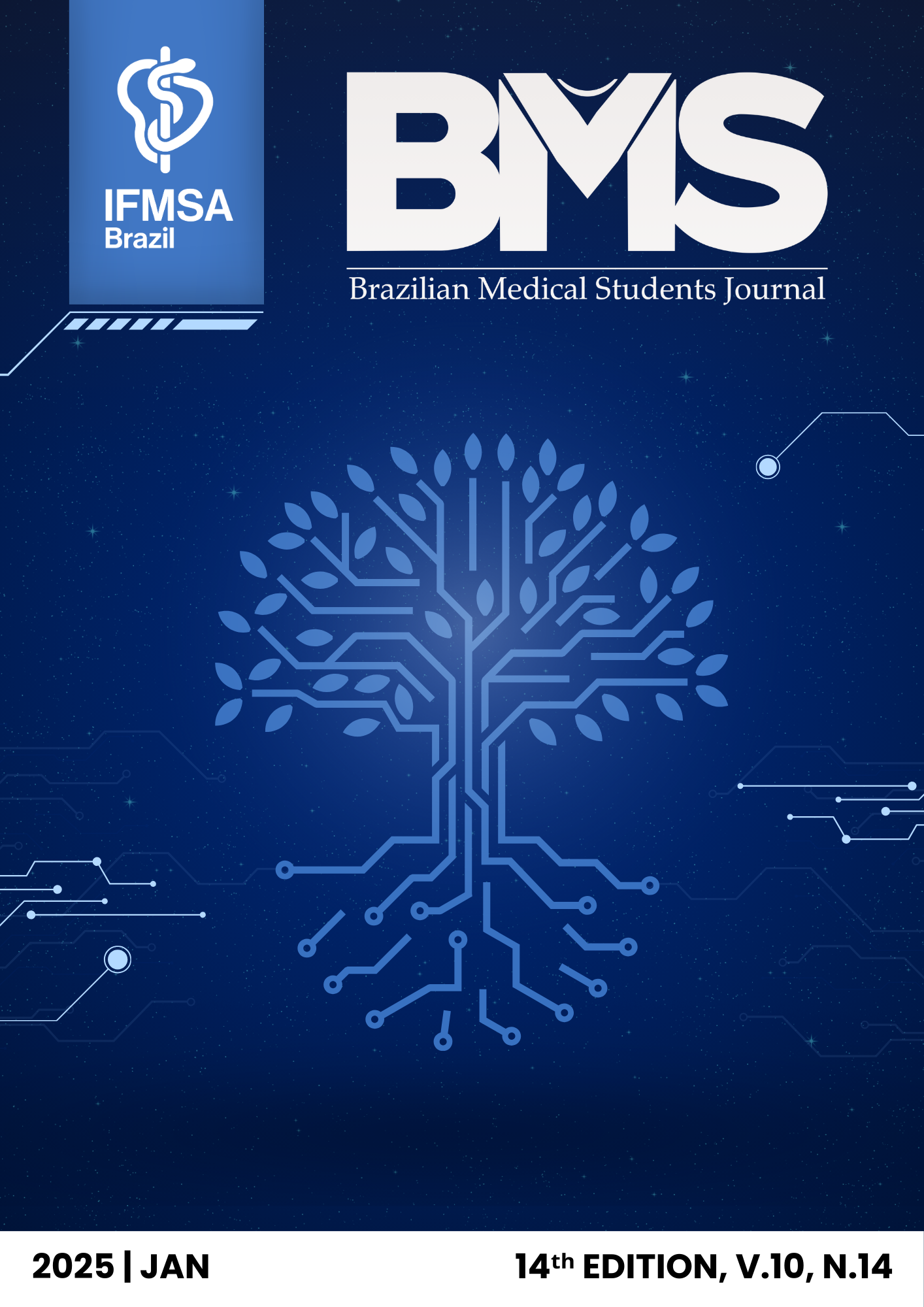Preoperative Assessment of Elective Colectomies: Risks of Incisional Hernia and Benefits of Prophylactic Mesh.
DOI:
https://doi.org/10.53843/bms.v10i14.845Keywords:
Colorectal Surgery, Incisional Hernia, Surgical Wound Dehiscence, EpidemiologyAbstract
Introdução: The postoperative period for patients undergoing colectomies is typically characterized by the occurrence of incisional hernia. This outcome is attributed to perioperative factors associated with high morbidity and mortality rates. This study assesses the profile of patients with aponeurotic dehiscence (DA), quantifies its prevalence, and evaluates the indication for prophylactic mesh according to the Vidal score.
Métodos: Patient records were analyzed for those who underwent elective colectomy of any segment with a median infraumbilical incision at “XXXX” between 06/01/2020 and 06/30/2021.
Resultados: The sample (n=73) has an average age of 61.2 years with a predominance of female patients. Among them, 26 exhibited aponeurotic dehiscence (DA+). This group consists of individuals over 40 years old [96.15% (n=26)], with ascites [7.69% (n=26)], jaundice [3.85% (n=26)], and anemia [38.46% (n=26)]. Major comorbidities in the DA+ group include malignant neoplasms [80.77% (n=26)], obesity [26.96% (n=26)], and smoking [19.23% (n=26)]. The Vidal score indicated that 92.30% of DA+ patients and 77.77% of DA- patients were recommended for prophylactic mesh use.
Discussão: Anemia, jaundice, ascites, malignant neoplasms, obesity, smoking, and malnutrition were associated with aponeurotic dehiscence. It is notable that some of these risk factors are modifiable and can be targeted for interventions to reduce the incidence of DA. The use of the Vidal score for risk stratification may aid in the early identification of patients with a higher likelihood of postoperative complications. The study is limited by its focus solely on preoperative factors.
Conclusão: The profile is predominantly characterized by female sex and advanced age, as well as risk factors such as anemia and ascites, and comorbidities like malignant neoplasms and obesity. Aponeurotic dehiscence affected 35.61% (n=73) of the patients, and 92.3% of those with DA+ had an indication for prophylactic mesh use.
References
Alvarez JFP, Cardero JR, Milá AB, Ojea MP. Hérnia incisional grande. Resultado del tratamiento quirúrgico com material protésico. Rev Cub Cir 1996; 35:0-0.
Höer J, Lawong G, Klinge U, Schumpelick V. Factors influencing the development of incisional hernia. A retrospective study of 2.983 laparotomy patients over a period of 10 years. Chirurg 2002; 73(5): 474-80.
Kenig J, Richter P, Zurawska S, Lasek A, Zbierska K. Risk factors for wound dehiscence after laparotomy - clinical control trial. Polski przeglad chirurgiczny. 2012;84(11):565-73.
Lima, HVG. Prevenção de deiscência precoce da aponeurose com tela de polipropileno pré-aponeurótica após laparotomias medianas: ensaio clínico randomizado [tese]. São Paulo: Universidade de São Paulo, Faculdade de Medicina, 2017. 113p.
Lima, Helber Vidal Gadelha. Prevenção de deiscência da aponeurose com uso profilático de tela pré-aponeurótica em laparotomias de emergência: ensaio clínico randomizado [tese]. São Paulo:, Faculdade de Medicina; 2019 [citado 2019-08-26]. Disponível em: http://www.teses.usp.br/teses/disponiveis/5/5152/tde-23082019- 122526/.
Medeiros AC, Lima FP, Dantas Filho A M, Melo NMC, Azevedo IM. A nicotina atua como fator deletério na reparação da parede abdominal. Acta Cirúrgica Brasileira 2003; 18(1)19-23.
Morais AAC, Paulo DNS. Afecções e condições digestivas que aumentam a incidência de complicações cirúrgicas. In: Complicações em Cirurgia do Aparelho Digestivo. Rocha PRS, Rodrigues MAG, v. 2, Rio de Janeiro: Atheneu 1998; 1-19
Rodriguez-Hermosa JI, Codina-Cazador A, Ruiz B, Roig J, Girones J, Pujadas M, et al. [Risk factors for acute abdominal wall dehiscence after laparotomy in adults]. Cirugia espanola. 2005;77(5):280-6.
Sandy-Hodgetts K, Carville K, Leslie GD. Determining risk factors for surgical wound dehiscence: a literature review. Int Wound J 2015; 12:265-275.
Soares LA, Margarido NF. Fechamento da parede abdominal. In: Aspectos Técnicos em Cirurgia. Margarido NF. v. 2, Rio de Janeiro: Atheneu, 1999; 77-86.
Van Ramshorst GH, Nieuwenhuizen J, Hop WC, Arends P, Boom J, Jeekel J, et al. Abdominal wound dehiscence in adults: development and validation of a risk model. World journal of surgery. 2010;34(1):20-7.
Vidovic D, Jurisic D, Franjic BD, Glavan E, Ledinsky M, Bekavac-Beslin M. Factors affecting recurrence after incisional hernia repair. Hernia 2006; 10(4):322-25.
Downloads
Published
Issue
Section
License
Copyright (c) 2025 Cristiano Marciano Duarte, Marco Aurelio Leão Beltrami, Claudia Nishida Hasimoto, Walmar Kerche De Oliveira, Marcone Lima Sobreira

This work is licensed under a Creative Commons Attribution 4.0 International License.
User licenses define how readers and the general public can use the article without needing other permissions. The Creative Commons public licenses provide a standard set of terms and conditions that creators and other rights holders can use to share original works of authorship and other material subjects to copyright and certain other rights specified in the public license available at https:// creativecommons.org/licenses/by/4.0/deed.pt_BR. Using the 4.0 International Public License, Brazilian Medical Students (BMS) grants the public permission to use published material under specified terms and conditions agreed to by the journal. By exercising the licensed rights, authors accept and agree to abide by the terms and conditions of the Creative Commons Attribution 4.0 International Public License.






